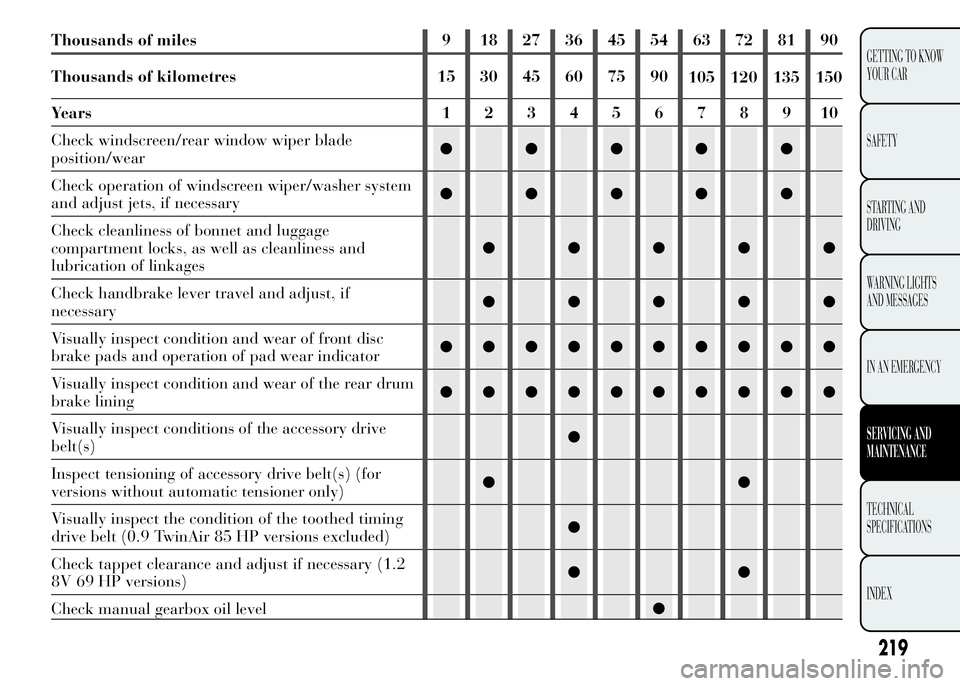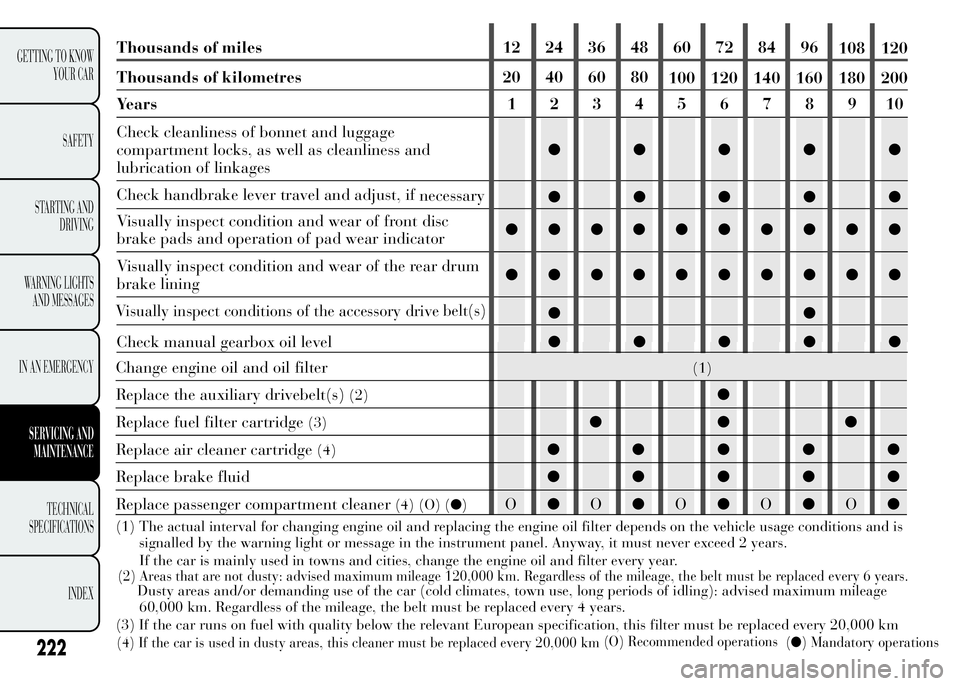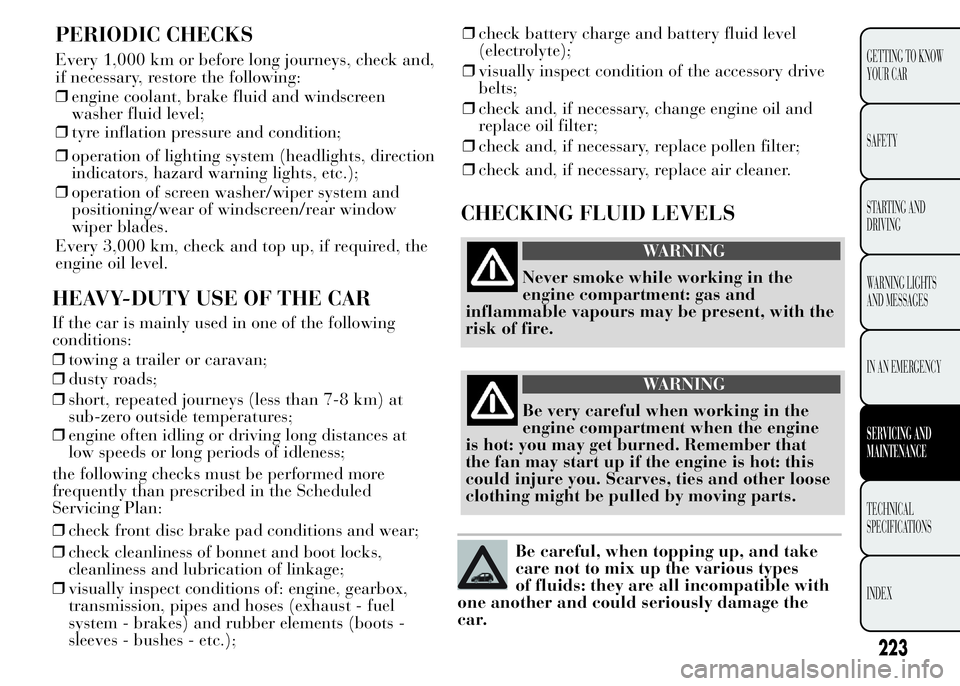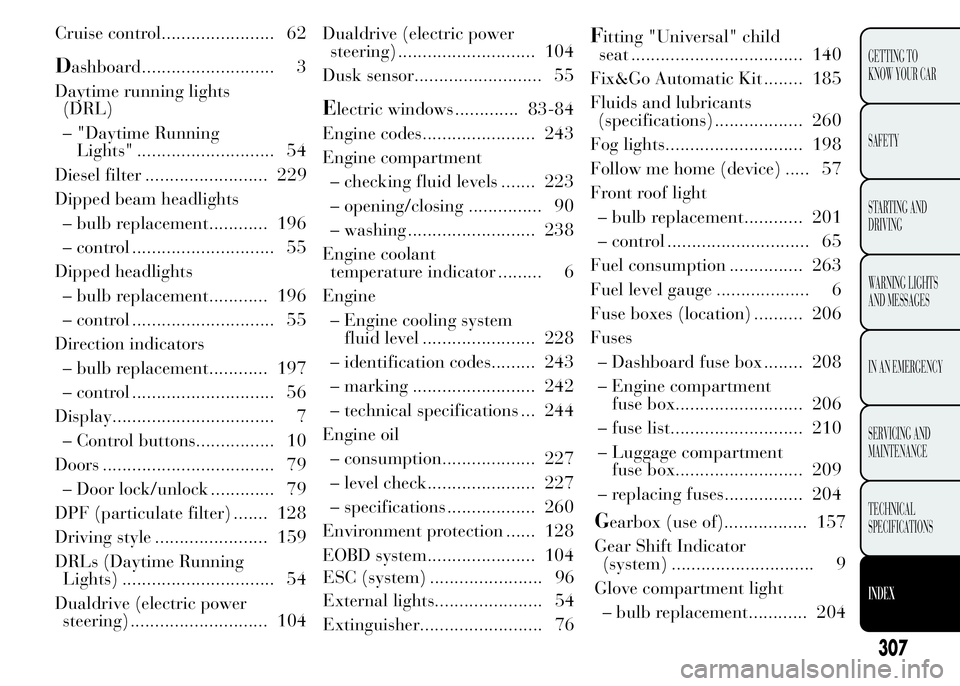check oil Lancia Ypsilon 2015 Owner handbook (in English)
[x] Cancel search | Manufacturer: LANCIA, Model Year: 2015, Model line: Ypsilon, Model: Lancia Ypsilon 2015Pages: 315, PDF Size: 10.85 MB
Page 222 of 315

SCHEDULED SERVICING PLAN
218
GETTING TO KNOW
YOUR CAR
SAFETY
STARTING AND
DRIVING
WARNING LIGHTS
AND MESSAGES
IN AN EMERGENCY
SERVICING AND
MAINTENANCE
TECHNICAL
SPECIFICATIONS
INDEX
PETROL VERSIONS
The checks listed in the Scheduled Servicing Plan, after reaching 120,000 km/8 years, must be cyclically
repeated starting from the first interval, thus following the same intervals as before.
Thousands of miles 9 18 27 36 45 54 63 72 81 90
Thousands of kilometres 15 30 45 60 75 90
105 120 135 150
Years12345678910
Check tyre condition/wear and adjust pressure, if
necessary; check “Fix&Go Automatic” kit recharge
expiry date (for versions/markets, where provided)●●●●●●●●●●
Check operation of lighting system (headlights,
direction indicators, hazard warning lights, luggage
compartment, passenger compartment, glove
compartment, instrument panel warning lights, etc.)●●●●●●●●●●
Check and, if necessary, top up fluid levels (engine
coolant, hydraulic clutch/brakes, screen washer,
battery, etc.)●●●●●●●●●●
Check exhaust emissions/smokiness●●●●●●●●●●
Use the diagnosis socket to check supply/engine
management system operation, emissions and, for
versions/markets, where provided, engine oil
degradation●●●●●●●●●●
Visually inspect condition of: exterior bodywork,
underbody protection, pipes and hoses (exhaust, fuel
system, brakes), rubber elements (boots, sleeves,
bushes, etc.)●●●●●
Page 223 of 315

219
GETTING TO KNOW
YOUR CAR
SAFETY
STARTING AND
DRIVING
WARNING LIGHTS
AND MESSAGES
IN AN EMERGENCY
SERVICING AND
MAINTENANCE
TECHNICAL
SPECIFICATIONS
INDEX
Thousands of miles 9 18 27 36 45 54 63 72 81 90
Thousands of kilometres 15 30 45 60 75 90
105 120 135 150
Years12345678910
Check windscreen/rear window wiper blade
position/wear●●●●●
Check operation of windscreen wiper/washer system
and adjust jets, if necessary●●●●●
Check cleanliness of bonnet and luggage
compartment locks, as well as cleanliness and
lubrication of linkages●●●●●
Check handbrake lever travel and adjust, if
necessary●●●●●
Visually inspect condition and wear of front disc
brake pads and operation of pad wear indicator●●●●●●●●●●
Visually inspect condition and wear of the rear drum
brake lining●●●●●●●●●●
Visually inspect conditions of the accessory drive
belt(s)●
Inspect tensioning of accessory drive belt(s) (for
versions without automatic tensioner only)●●
Visually inspect the condition of the toothed timing
drive belt (0.9 TwinAir 85 HP versions excluded)●
Check tappet clearance and adjust if necessary (1.2
8V 69 HP versions)●●
Check manual gearbox oil level●
Page 225 of 315

221
GETTING TO KNOW
YOUR CAR
SAFETY
STARTING AND
DRIVING
WARNING LIGHTS
AND MESSAGES
IN AN EMERGENCY
SERVICING AND
MAINTENANCE
TECHNICAL
SPECIFICATIONS
INDEX
DIESEL VERSIONS
The checks listed in the Scheduled Servicing Plan, after reaching 120,000 km/6 years, must be cyclically
repeated starting from the first interval, thus following the same intervals as before.
Thousands of miles 12 24 36 48 60 72 84 96
108 120
Thousands of kilometres 20 40 60 80
100 120 140 160 180 200
Years12345678910
Check tyre condition/wear and adjust pressure, if
necessary; check “Fix&Go Automatic” kit recharge
expiry date (for versions/markets, where provided)●●●●●●●●●●
Check operation of lighting system (headlights,
direction indicators, hazard warning lights, luggage
compartment, passenger compartment, glove
compartment, instrument panel warning lights, etc.)●●●●●●●●●●
Check and, if necessary, top up fluid levels (engine
coolant, hydraulic clutch/brakes, screen washer,
battery, etc.)●●●●●●●●●●
Check exhaust emissions/smokiness●●●●●●●●●●
Use the diagnosis socket to check supply/engine
management system operation, emissions and, for
versions/markets, where provided, engine oil
degradation●●●●●●●●●●
Visually inspect condition of: exterior bodywork,
underbody protection, pipes and hoses (exhaust, fuel
system, brakes), rubber elements (boots, sleeves,
bushes, etc.)●●●●●
Check windscreen/rear window wiper blade
position/wear●●●●●
Check operation of windscreen wiper/washer system
and adjust jets, if necessary●●●●●
Page 226 of 315

222
GETTING TO KNOW
YOUR CAR
SAFETY
STARTING AND
DRIVING
WARNING LIGHTS
AND MESSAGES
IN AN EMERGENCY
SERVICING AND
MAINTENANCE
TECHNICAL
SPECIFICATIONS
INDEX
Thousands of miles 12 24 36 48 60 72 84 96
108 120
Thousands of kilometres 20 40 60 80
100 120 140 160 180 200
Years12345678910
Check cleanliness of bonnet and luggage
compartment locks, as well as cleanliness and
lubrication of linkages●●●●●
Check handbrake lever travel and adjust, if
necessary
●●●●●
Visually inspect condition and wear of front disc
brake pads and operation of pad wear indicator●●●●●●●●●●
Visually inspect condition and wear of the rear drum
brake lining●●●●●●●●●●
Visually inspect conditions of the accessory drivebelt(s)●●
Check manual gearbox oil level●●●●●
Change engine oil and oil filter(1)
Replace the auxiliary drivebelt(s)(2)●
Replace fuel filter cartridge
(3)●●●
Replace air cleaner cartridge
(4)●●●●●
Replace brake fluid●●●●●
Replace passenger compartment cleaner
(4) (O) (●)O●O●O●O●O●
(1) The actual interval for changing engine oil and replacing the engine oil filter depends on the vehicle usage conditions and is
signalled by the warning light or message in the instrument panel. Anyway, it must never exceed 2 years.
If the car is mainly used in towns and cities, change the engine oil and filter every year.
(2) Areas that are not dusty: advised maximum mileage 120,000 km. Regardless of the mileage, the belt must be replacedevery 6 years.Dusty areas and/or demanding use of the car (cold climates, town use, long periods of idling): advised maximum mileage
60,000 km. Regardless of the mileage, the belt must be replaced every 4 years.
(3) If the car runs on fuel with quality below the relevant European specification, this filter must be replaced every 20,000 km
(4) If the car is used in dusty areas, this cleaner must be replaced every 20,000 km(O) Recommended operations
(●) Mandatory operations
Page 227 of 315

223
GETTING TO KNOW
YOUR CAR
SAFETY
STARTING AND
DRIVING
WARNING LIGHTS
AND MESSAGES
IN AN EMERGENCY
SERVICING AND
MAINTENANCE
TECHNICAL
SPECIFICATIONS
INDEX
PERIODIC CHECKS
Every 1,000 km or before long journeys, check and,
if necessary, restore the following:
❒engine coolant, brake fluid and windscreen
washer fluid level;
❒tyre inflation pressure and condition;
❒operation of lighting system (headlights, direction
indicators, hazard warning lights, etc.);
❒operation of screen washer/wiper system and
positioning/wear of windscreen/rear window
wiper blades.
Every 3,000 km, check and top up, if required, the
engine oil level.
HEAVY-DUTY USE OF THE CAR
If the car is mainly used in one of the following
conditions:
❒towing a trailer or caravan;
❒dusty roads;
❒short, repeated journeys (less than 7-8 km) at
sub-zero outside temperatures;
❒engine often idling or driving long distances at
low speeds or long periods of idleness;
the following checks must be performed more
frequently than prescribed in the Scheduled
Servicing Plan:
❒check front disc brake pad conditions and wear;
❒check cleanliness of bonnet and boot locks,
cleanliness and lubrication of linkage;
❒visually inspect conditions of: engine, gearbox,
transmission, pipes and hoses (exhaust - fuel
system - brakes) and rubber elements (boots -
sleeves - bushes - etc.);❒check battery charge and battery fluid level
(electrolyte);
❒visually inspect condition of the accessory drive
belts;
❒check and, if necessary, change engine oil and
replace oil filter;
❒check and, if necessary, replace pollen filter;
❒check and, if necessary, replace air cleaner.
CHECKING FLUID LEVELS
WARNING
Never smoke while working in the
engine compartment: gas and
inflammable vapours may be present, with the
risk of fire.
WARNING
Be very careful when working in the
engine compartment when the engine
is hot: you may get burned. Remember that
the fan may start up if the engine is hot: this
could injure you. Scarves, ties and other loose
clothing might be pulled by moving parts.
Be careful, when topping up, and take
care not to mix up the various types
of fluids: they are all incompatible with
one another and could seriously damage the
car.
Page 231 of 315

ENGINE OIL
Check the oil level a few minutes (about five) after
the engine has stopped, with the car parked on
level ground.
For 1.2 8V 69 HP and 1.3 16V MultiJet
versions
Remove the engine oil dipstick B, clean it with a
cloth that does not leave any trace and resinsert it.
Extract it again and check that the level is
between the MIN and MAX marks on the dipstick.
The range between the MIN and MAX marks
corresponds to about 1 litre of oil.
If the oil level is near or under the MIN mark, add
oil through the filler A until it reaches the MAX
mark.
The oil level should never exceed the
MAX mark.
For 0.9 TwinAir 85 HP versions
The engine oil dipstick A is integral with plug A.
Loosen the plug, clean the dipstick with a cloth
that does not leave traces, reinsert the dipstick
and re-tighten the plug. Extract the plug again
and check that the level is between the MIN and
MAX marks on the dipstick.Engine oil consumption
The maximum engine oil consumption is usually
400 grams every 1,000 km.
During the initial period of usage for the car, the
engine is bedding in, therefore the engine oil
consumption may settle down only after the first
5,000 - 6,000 km.
IMPORTANT After adding or changing the oil, let
the engine run for a few seconds and wait a few
minutes after switching it off before checking the
level.
Do not add oil with characteristics that
are different from those of the oil
currently in the engine.
Used engine oil and filter contain
harmful substances for the
environment. You are advised to go to a
Lancia Dealership to have the oil and filters
replaced.
227
GETTING TO KNOW
YOUR CAR
SAFETY
STARTING AND
DRIVING
WARNING LIGHTS
AND MESSAGES
IN AN EMERGENCY
SERVICING AND
MAINTENANCE
TECHNICAL
SPECIFICATIONS
INDEX
Page 243 of 315

INTERIORS
Periodically check for water puddles under the
mats that could cause the panels to rust.
WARNING
Never use flammable products, such
as petrol ether or rectified petrol to
clean the inside of the car. The electrostatic
charges which are generated by rubbing
during the cleaning operation may cause a
fire.
WARNING
Do not keep aerosol cans in the car:
they might explode. Aerosol cans
must not be exposed to a temperature
exceeding 50°C. When the car is exposed to
sunlight, internal temperature can greatly
exceed this value.SEATS AND FABRIC PARTS
Remove dust with a soft brush or a vacuum
cleaner. It is advisable to use a moist brush on
velvet upholstery.
Rub the seats with a sponge and a solution of
water and mild soap.
PLASTIC AND COATED PARTS
Clean interior plastic parts with a damp cloth (if
possible made from microfibre), and a solution
of water and neutral, non-abrasive detergent. To
clean oily or persistent stains, use specific
products free from solvents and designed to
maintain the original appearance and colour of
the components.
Remove any dust using a microfibre cloth, if
necessary moistened with water. The use of paper
tissues is not recommended as these may leave
residues.
239
GETTING TO KNOW
YOUR CAR
SAFETY
STARTING AND
DRIVING
WARNING LIGHTS
AND MESSAGES
IN AN EMERGENCY
SERVICING AND
MAINTENANCE
TECHNICAL
SPECIFICATIONS
INDEX
IMPORTANT Never use alcohol, petrols and
derivatives to clean the instrument panel lens.
Page 311 of 315

Cruise control....................... 62
Dashboard........................... 3
Daytime running lights
(DRL)
– "Daytime Running
Lights" ............................ 54
Diesel filter ......................... 2
Dipped beam headlights
– bulb replacement............ 196
– control ............................. 55
Dipped headlights
– bulb replacement............ 196
– control ............................. 55
Direction indicators
– bulb replacement............ 197
– control ............................. 56
Display................................. 7
– Control buttons................ 10
Doors ................................... 79
– Door lock/unlock ............. 79
DPF (particulate filter) ....... 128
Driving style ....................... 159
DRLs (Daytime Running
Lights) ............................... 54
Dualdrive (electric power
steering) ............................ 104Dualdrive (electric power
steering) ............................ 104
Dusk sensor.......................... 55
Electric windows ............. 83-84
Engine codes....................... 243
Engine compartment
– checking fluid levels ....... 223
– opening/closing ............... 90
– washing .......................... 238
Engine coolant
temperature indicator ......... 6
Engine
– Engine cooling system
fluid level ....................... 228
– identification codes......... 243
– marking ......................... 242
– technical specifications ... 244
Engine oil
– consumption................... 227
– level check...................... 227
– specifications .................. 260
Environment protection ...... 128
EOBD system...................... 104
ESC (system) ....................... 96
External lights...................... 54
Extinguisher......................... 76
Fitting "Universal" child
seat ................................... 140
Fix&Go Automatic Kit ........ 185
Fluids and lubricants
(specifications) .................. 260
Fog lights............................ 198
Follow me home (device) ..... 57
Front roof light
– bulb replacement............ 201
– control ............................. 65
Fuel consumption ............... 263
Fuel level gauge ................... 6
Fuse boxes (location) .......... 206
Fuses
– Dashboard fuse box ........ 208
– Engine compartment
fuse box.......................... 206
– fuse list........................... 210
– Luggage compartment
fuse box.......................... 20
– replacing fuses................ 204
307
GETTING TO
KNOW YOUR CAR
SAFETY
STARTING AND
DRIVING
WARNING LIGHTS
AND MESSAGES
IN AN EMERGENCY
SERVICING AND
MAINTENANCE
TECHNICAL
SPECIFICATIONS
INDEX
Gearbox (use of)................. 157
Gear Shift Indicator
(system) ............................. 9
Glove compartment light
– bulb replacement............ 2049 29